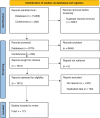Linkage to care and prevention after HIV self-testing: a systematic review and meta-analysis
- PMID: 39663188
- PMCID: PMC11634545
- DOI: 10.1002/jia2.26388
Linkage to care and prevention after HIV self-testing: a systematic review and meta-analysis
Abstract
Introduction: Effective linkage to prevention and care is a crucial step following HIV testing services. This systematic review aimed to determine the proportion of individuals linked to prevention and care after HIV self-testing (HIVST) and describe factors associated with linkage.
Methods: Following PRISMA guidelines, a comprehensive search across eight databases (2010-October 2023) identified studies on linkage to care after HIVST, defined as receiving a confirmatory test or initiating antiretroviral therapy (ART) if the self-test was reactive, and/or pre-exposure prophylaxis (PrEP) if the self-test was non-reactive. A random-effects meta-analysis summarized the findings and meta-regression explored study-level covariates, such as world region, population type and service delivery model, that might explain the between-study heterogeneity.
Results: From 10,071 screened studies, 173 were included in the meta-analysis. The majority of studies focused on key populations in Africa using unassisted, oral fluid-based HIVST kits. Among those with reactive HIVST results, 92% (95% confidence interval [CI]: 88-95) were linked to confirmatory testing (n = 124 studies), and 89% (95% CI: 84-93) of newly diagnosed individuals initiated ART (n = 88 studies). Overall, 84% (95% CI: 74-93) of self-testers were linked to care (n = 69 studies). However, only 9% (95% CI: 2-19) of individuals with non-reactive HIVST results were linked to PrEP services (n = 9 studies). Assisted HIVST was associated with higher linkage rates to confirmatory testing and ART initiation compared to unassisted testing. Meta-regression revealed that the type of delivery model for the HIVST kits influenced linkage and that individuals who obtained their HIVST kits through a social network-based approach (SNA) were more likely to be linked to confirmatory testing (adjusted odds ratio = 1.28 [95% CI: 1.10-1.50], p = 0.001) compared to non-SNA service delivery model.
Discussion: In the context of expanding HIVST services globally, we found that linkage to confirmatory testing and ART initiation after HIVST is generally high, particularly when assisted HIVST or SNA-based distribution is used.
Conclusions: Strengthening timely linkage is vital for improving health outcomes, reducing HIV transmission and achieving the UNAIDS 95-95-95 goal. Ongoing research and collaboration with community-based organizations are needed to overcoming barriers and ensuring positive outcomes for those using HIVST.
Prospero number: CRD42022357570.
Keywords: ART; HIV; PrEP; confirmatory testing; linkage; self‐test.
© 2024 The Author(s). Journal of the International AIDS Society published by John Wiley & Sons Ltd on behalf of International AIDS Society.
Conflict of interest statement
All authors declare no competing interests.
Figures
References
-
- Joint United Nations Programme on HIV/AIDS (UNAIDS) . In Danger: UNAIDS Global AIDS Update 2022 [Internet]. Geneva, Switzerland; 2022. [cited March 17, 2024]. Available from: https://www.unaids.org/en/resources/documents/2022/in‐danger‐global‐aids...
-
- World Health Organization . Consolidated guidelines on HIV testing services for a changing epidemic 2019. Geneva: World Health Organization; 2020.
-
- World Health Organization . Guidelines on HIV self‐testing and partner notification: supplement to consolidated guidelines on HIV testing services [Internet]. Geneva, Switzerland; 2016. [cited March 17, 2024]. Available from: https://apps.who.int/iris/handle/10665/251655 - PubMed
-
- Thirumurthy H, Masters SH, Mavedzenge SN, Maman S, Omanga E, Agot K. Promoting male partner HIV testing and safer sexual decision making through secondary distribution of self‐tests by HIV‐negative female sex workers and women receiving antenatal and post‐partum care in Kenya: a cohort study. Lancet HIV. 2016;3(6):e266–e274. - PMC - PubMed
Publication types
MeSH terms
Grants and funding
- 001/WHO_/World Health Organization/International
- GNT1193955/Australian National Health and Medical Research Council (NHMRC) Emerging Investigator Grant
- GNT1172900/Australian NHMRC Leadership Investigator Grant
- GNT1172873/Australian National Health and Medical Research Council (NHMRC) Emerging Investigator Grant
LinkOut - more resources
Full Text Sources
Medical
Research Materials
Miscellaneous



